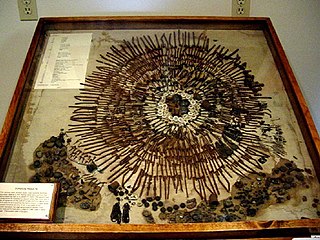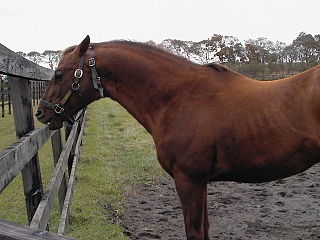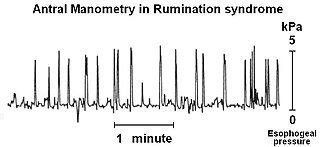Related Research Articles
An eating disorder is a mental disorder defined by abnormal eating behaviors that negatively affect a person's physical or mental health. Types of eating disorders include binge eating disorder, where the patient eats a large amount in a short period of time; anorexia nervosa, where the person has an intense fear of gaining weight and restricts food or overexercises to manage this fear; bulimia nervosa, where individuals eat a large quantity (binging) then try to rid themselves of the food (purging); pica, where the patient eats non-food items; rumination syndrome, where the patient regurgitates undigested or minimally digested food; avoidant/restrictive food intake disorder (ARFID), where people have a reduced or selective food intake due to some psychological reasons; and a group of other specified feeding or eating disorders. Anxiety disorders, depression and substance abuse are common among people with eating disorders. These disorders do not include obesity. People often experience comorbidity between an eating disorder and OCD. It is estimated 20-60% of patients with an ED have a history of OCD.

Dietary fiber or roughage is the portion of plant-derived food that cannot be completely broken down by human digestive enzymes. Dietary fibers are diverse in chemical composition, and can be grouped generally by their solubility, viscosity, and fermentability, which affect how fibers are processed in the body. Dietary fiber has two main components: soluble fiber and insoluble fiber, which are components of plant-based foods, such as legumes, whole grains and cereals, vegetables, fruits, and nuts or seeds. A diet high in regular fiber consumption is generally associated with supporting health and lowering the risk of several diseases. Dietary fiber consists of non-starch polysaccharides and other plant components such as cellulose, resistant starch, resistant dextrins, inulin, lignins, chitins, pectins, beta-glucans, and oligosaccharides.

Digestion is the breakdown of large insoluble food molecules into small water-soluble food molecules so that they can be absorbed into the watery blood plasma. In certain organisms, these smaller substances are absorbed through the small intestine into the blood stream. Digestion is a form of catabolism that is often divided into two processes based on how food is broken down: mechanical and chemical digestion. The term mechanical digestion refers to the physical breakdown of large pieces of food into smaller pieces which can subsequently be accessed by digestive enzymes. Mechanical digestion takes place in the mouth through mastication and in the small intestine through segmentation contractions. In chemical digestion, enzymes break down food into the small molecules the body can use.

Pica is the eating or craving of things that are not food. It can be a disorder in itself or medical phenomena. The ingested or craved substance may be biological, natural or manmade. The term was drawn directly from the medieval Latin word for magpie, a bird subject to much folklore regarding its opportunistic feeding behaviors.

Eating is the ingestion of food, typically to provide a heterotrophic organism with energy and to allow for growth. Animals and other heterotrophs must eat in order to survive — carnivores eat other animals, herbivores eat plants, omnivores consume a mixture of both plant and animal matter, and detritivores eat detritus. Fungi digest organic matter outside their bodies as opposed to animals that digest their food inside their bodies. For humans, eating is an activity of daily living. Some individuals may limit their amount of nutritional intake. This may be a result of a lifestyle choice, due to hunger or famine, as part of a diet or as religious fasting.

Xylitol is a chemical compound with the formula C
5H
12O
5, or HO(CH2)(CHOH)3(CH2)OH; specifically, one particular stereoisomer with that structural formula. It is a colorless or white crystalline solid that is freely soluble in water. It can be classified as a polyalcohol and a sugar alcohol, specifically an alditol. The name derives from Ancient Greek: ξύλον, xyl[on] 'wood', with the suffix -itol used to denote sugar alcohols.

Chewing gum is a soft, cohesive substance designed to be chewed without being swallowed. Modern chewing gum is composed of gum base, sweeteners, softeners/plasticizers, flavors, colors, and, typically, a hard or powdered polyol coating. Its texture is reminiscent of rubber because of the physical-chemical properties of its polymer, plasticizer, and resin components, which contribute to its elastic-plastic, sticky, chewy characteristics.
Binge eating disorder (BED) is an eating disorder characterized by frequent and recurrent binge eating episodes with associated negative psychological and social problems, but without the compensatory behaviors common to bulimia nervosa, OSFED, or the binge-purge subtype of anorexia nervosa.
Gastric bypass surgery refers to a technique in which the stomach is divided into a small upper pouch and a much larger lower "remnant" pouch and then the small intestine is rearranged to connect to both. Surgeons have developed several different ways to reconnect the intestine, thus leading to several different gastric bypass procedures (GBP). Any GBP leads to a marked reduction in the functional volume of the stomach, accompanied by an altered physiological and physical response to food.

Chewing or mastication is the process by which food is crushed and ground by teeth. It is the first step of digestion, and it increases the surface area of foods to allow a more efficient break down by enzymes. During the mastication process, the food is positioned by the cheek and tongue between the teeth for grinding. The muscles of mastication move the jaws to bring the teeth into intermittent contact, repeatedly occluding and opening. As chewing continues, the food is made softer and warmer, and the enzymes in saliva begin to break down carbohydrates in the food. After chewing, the food is swallowed. It enters the esophagus and via peristalsis continues on to the stomach, where the next step of digestion occurs. Increasing the number of chews per bite increases relevant gut hormones. Studies suggest that chewing may decrease self-reported hunger and food intake. Chewing gum has been around for many centuries; there is evidence that northern Europeans chewed birch bark tar 9,000 years ago.

Ileus is a disruption of the normal propulsive ability of the intestine. It can be caused by lack of peristalsis or by mechanical obstruction. The word 'ileus' is from Ancient Greek eileós. The term 'subileus' refers to a partial obstruction.
A food or eating addiction is any behavioral addiction that is primarily characterized by the compulsive consumption of palatable food items which markedly activate the reward system in humans and other animals despite adverse consequences.
Nicotine gum is a chewing gum containing the active ingredient nicotine polacrilex. It is a type of nicotine replacement therapy (NRT) used alone or in combination with other pharmacotherapy for smoking cessation and for quitting smokeless tobacco.

Zoopharmacognosy is a behaviour in which non-human animals self-medicate by selecting and ingesting or topically applying plants, soils and insects with medicinal properties, to prevent or reduce the harmful effects of pathogens, toxins, and even other animals. The term derives from Greek roots zoo ("animal"), pharmacon, and gnosy ("knowing").

Cribbing is a form of stereotypy (equine oral stereotypic behaviour), otherwise known as wind sucking or crib-biting. Cribbing is considered to be an abnormal, compulsive behavior seen in some horses, and is often labelled a stable vice. The major factors that cause cribbing include stress, stable management, genetic and gastrointestinal irritability.

Rumination syndrome, or merycism, is a chronic motility disorder characterized by effortless regurgitation of most meals following consumption, due to the involuntary contraction of the muscles around the abdomen. There is no retching, nausea, heartburn, odour, or abdominal pain associated with the regurgitation, as there is with typical vomiting, and the regurgitated food is undigested. The disorder has been historically documented as affecting only infants, young children, and people with cognitive disabilities . It is increasingly being diagnosed in a greater number of otherwise healthy adolescents and adults, though there is a lack of awareness of the condition by doctors, patients and the general public.
Night eating syndrome (NES) is an eating disorder, characterized by a delayed circadian pattern of food intake. Although there is some degree of comorbidity with binge eating disorder, it differs from binge eating in that the amount of food consumed in the night is not necessarily objectively large nor is a loss of control over food intake required. It was originally described by Albert Stunkard in 1955 and is currently included in the other specified feeding or eating disorder category of the DSM-5. Research diagnostic criteria have been proposed and include evening hyperphagia and/or nocturnal awakening and ingestion of food two or more times per week. The person must have awareness of the night eating to differentiate it from the parasomnia sleep-related eating disorder (SRED). Three of five associated symptoms must also be present: lack of appetite in the morning, urges to eat at night, belief that one must eat in order to fall back to sleep at night, depressed mood, and/or difficulty sleeping.
Hedonic hunger or hedonic hyperphagia is "the drive to eat to obtain pleasure in the absence of an energy deficit." Particular foods may have a high "hedonic rating" or individuals may have increased susceptibility to environmental food cues. Weight loss programs may aim to control or to compensate for hedonic hunger. Therapeutic interventions may influence hedonic eating behavior.
Chew and Spit is a compensatory behavior associated with several eating disorders that involves the chewing of food and spitting it out before swallowing, often as an attempt to avoid ingestion of unwanted or unnecessary calories. CS can be used as a way to taste food viewed as “forbidden” or unhealthy. Individuals who partake in CS typically have an increased desire for thinness, increased lack of control (LOC) and body dissatisfaction. CS can serve different functions such as replacing vomiting and/or binging or as an additional behavior to many eating disorders.
References
- ↑ Corwin, Rebecca L; Buda-Levin, Ariel (2004). "Behavioral models of binge-type eating". Physiology & Behavior . 82 (1): 123–130. doi:10.1016/j.physbeh.2004.04.036. PMID 15234600.
- 1 2 Kalat, James W (2013). Biological Psychology, 11th edition. Wadsworth. p. 302. ISBN 978-1-111-83952-9.
- 1 2 "Chewing Gum Associated With Enhanced Bowel Recovery After Colon Surgery". Science Daily . August 19, 2008. Retrieved June 7, 2014.
- ↑ Fitzgerald, Edward F.; Ahmed, Irfan (September 10, 2009). "Systematic Review and Meta-Analysis of Chewing-Gum Therapy in the Reduction of Postoperative Paralytic Ileus Following Gastrointestinal Surgery". World Journal of Surgery. 33 (12): 2557–66. doi:10.1007/s00268-009-0104-5. PMID 19763686.
- ↑ Robertson, Denise M (2001). "Prolonged effects of modified sham feeding on energy substrate mobilization". The American Journal of Clinical Nutrition . 73 (1): 111–117. doi: 10.1093/ajcn/73.1.111 . PMID 11124759.
- ↑ Arosio, Maura (2004). "Effects of modified sham feeding on ghrelin levels in healthy human subjects". The Journal of Clinical Endocrinology and Metabolism . 89 (10): 5101–5104. doi: 10.1210/jc.2003-032222 . PMID 15472212.